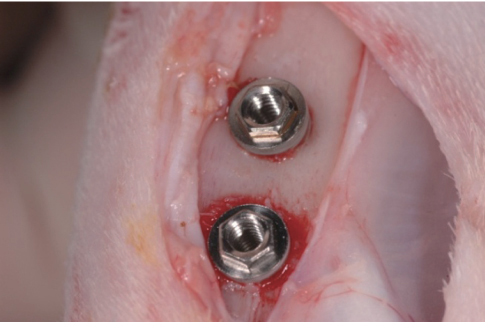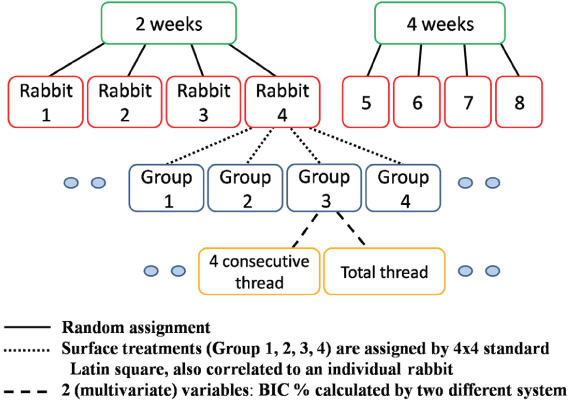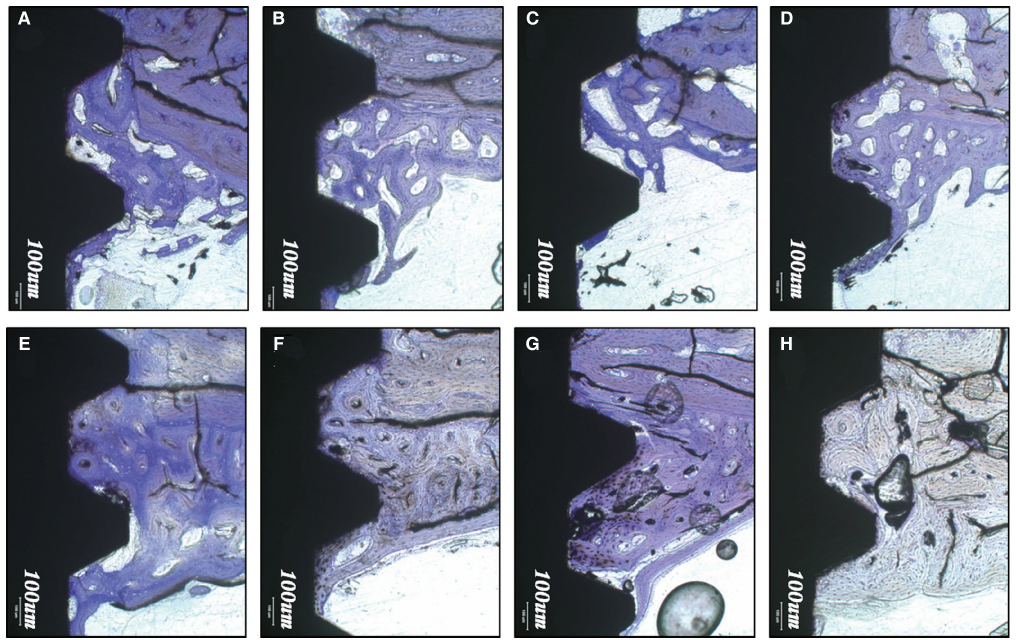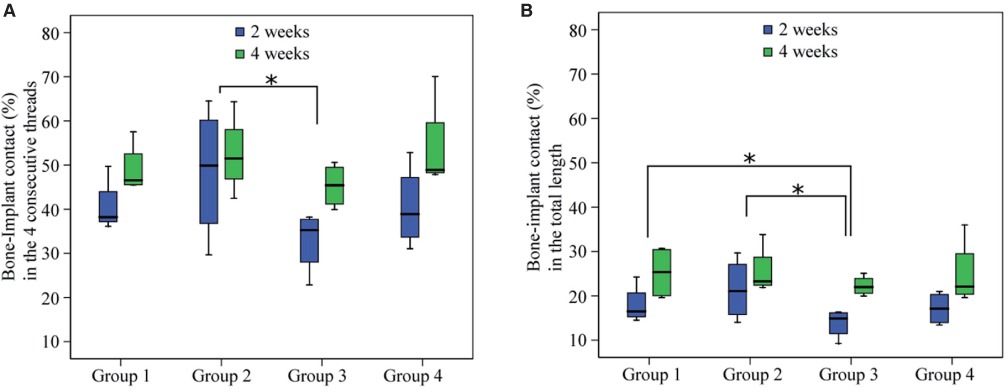J Adv Prosthodont.
2014 Feb;6(1):14-21. 10.4047/jap.2014.6.1.14.
Investigation of anodized titanium implants coated with triterpenoids extracted from black cohosh: an animal study
- Affiliations
-
- 1Department of Prosthodontics & Dental Research Institute, Seoul National University Dental Hospital, School of Dentistry, Seoul National University, Seoul, Republic of Korea. ksy0617@snu.ac.kr
- 2Department of Orthodontics, School of Dentistry, Seoul National University, Seoul, Republic of Korea.
- 3Department of Oriental Medicinal Materials & Processing, College of Life Sciences, KyungHee University, Seoul, Republic of Korea.
- 4Department of Prosthodontics, Asan Medical Center, College of Medicine, University of Ulsan, Seoul, Republic of Korea.
- KMID: 2176565
- DOI: http://doi.org/10.4047/jap.2014.6.1.14
Abstract
- PURPOSE
The purpose of this study was to evaluate bone response to anodized titanium implants coated with the extract of black cohosh, Asarum Sieboldii, and pharbitis semen.
MATERIALS AND METHODS
Forty anodized titanium implants were prepared as follows: group 1 was for control; group 2 were implants soaked in a solution containing triterpenoids extracted from black cohosh for 24 hours; group 3 were implants soaked in a solution containing extracts of black cohosh and Asarum Sieboldii for 24 hours; group 4 were implants soaked in a solution containing extracts of pharbitis semen for 24 hours. The implants from these groups were randomly and surgically implanted into the tibiae of ten rabbits. After 1, 2, and 4 weeks of healing, the nondecalcified ground sections were subjected to histological observation, and the percentage of bone-to-implant contact (BIC%) was calculated.
RESULTS
All groups exhibited good bone healing with the bone tissue in direct contact with the surface of the implant. Group 2 (52.44 +/- 10.98, 25.54 +/- 5.56) showed a significantly greater BIC% compared to that of group 3 (45.34 +/- 5.00, 22.24 +/- 2.20) with respect to the four consecutive threads and total length, respectively. The BIC% of group 1 (25.22 +/- 6.00) was significantly greater than that of group 3 (22.24 +/- 2.20) only for total length.
CONCLUSION
This study did not show any remarkable effects of the extract of black coshosh and the other natural products on osseointegration of anodized titanium implants as coating agents. Further studies about the application method of the natural products on to the surface of implants are required.
Keyword
MeSH Terms
Figure
Reference
-
1. Brånemark PI, Adell R, Breine U, Hansson BO, Lindström J, Ohlsson A. Intra-osseous anchorage of dental prostheses. I. Experimental studies. Scand J Plast Reconstr Surg. 1969; 3:81–100.2. Ostman PO. Immediate/early loading of dental implants. Clinical documentation and presentation of a treatment concept. Periodontol 2000. 2008; 47:90–112.3. Albrektsson T, Wennerberg A. Oral implant surfaces: Part 1-review focusing on topographic and chemical properties of different surfaces and in vivo responses to them. Int J Prosthodont. 2004; 17:536–543.4. Albrektsson T, Wennerberg A. Oral implant surfaces: Part 2-review focusing on clinical knowledge of different surfaces. Int J Prosthodont. 2004; 17:544–564.5. Junker R, Dimakis A, Thoneick M, Jansen JA. Effects of implant surface coatings and composition on bone integration: a systematic review. Clin Oral Implants Res. 2009; 20:185–206.6. Avila G, Misch K, Galindo-Moreno P, Wang HL. Implant surface treatment using biomimetic agents. Implant Dent. 2009; 18:17–26.7. Gullo VP, McAlpine J, Lam KS, Baker D, Petersen F. Drug discovery from natural products. J Ind Microbiol Biotechnol. 2006; 33:523–531.8. Lee KH. Discovery and development of natural product-derived chemotherapeutic agents based on a medicinal chemistry approach. J Nat Prod. 2010; 73:500–516.9. Putnam SE, Scutt AM, Bicknell K, Priestley CM, Williamson EM. Natural products as alternative treatments for metabolic bone disorders and for maintenance of bone health. Phytother Res. 2007; 21:99–112.10. Li JX, Yu ZY. Cimicifugae rhizoma: from origins, bioactive constituents to clinical outcomes. Curr Med Chem. 2006; 13:2927–2951.11. Kim HY, Kim CS, Jhon GJ, Moon IS, Choi SH, Cho KS, Chai JK, Kim CK. The effect of safflower seed extract on periodontal healing of 1-wall intrabony defects in beagle dogs. J Periodontol. 2002; 73:1457–1466.12. Baek EJ. The extract of Pharbitis nil Choisy has bone regenerative potential in the healing process of calvarial defects in a rabbit model. Seoul: Kyunghee Univ;2009. Master's Thesis.13. Chen LL, Tang Q, Yan J. Therapeutic effect of aqueous-extract from a traditional Chinese medical herb Drynaria fortunei on rat experimental model of alveolar bone resorption. Zhongguo Zhong Yao Za Zhi. 2004; 29:549–553.14. Kesavalu L, Vasudevan B, Raghu B, Browning E, Dawson D, Novak JM, Correll MC, Steffen MJ, Bhattacharya A, Fernandes G, Ebersole JL. Omega-3 fatty acid effect on alveolar bone loss in rats. J Dent Res. 2006; 85:648–652.15. Wuttke W, Gorkow C, Seidlová-Wuttke D. Effects of black cohosh (Cimicifuga racemosa) on bone turnover, vaginal mucosa, and various blood parameters in postmenopausal women: a double-blind, placebo-controlled, and conjugated estrogens-controlled study. Menopause. 2006; 13:185–196.16. Li JX, Liu J, He CC, Yu ZY, Du Y, Kadota S, Seto H. Triterpenoids from Cimicifugae rhizoma, a novel class of inhibitors on bone resorption and ovariectomy-induced bone loss. Maturitas. 2007; 58:59–69.17. Ernst M, Heath JK, Schmid C, Froesch RE, Rodan GA. Evidence for a direct effect of estrogen on bone cells in vitro. J Steroid Biochem. 1989; 34:279–284.18. Jung WS, Yoo HM, Seo SW, Cho JK, Son JW, Park MC, Choi CM, Yeon SR, Hwang SW, Kim YW, Song DS, Chae YS, Park SJ, Shin MK, Song HJ. Anti-inflammatory effect of extract of Asaum sieboldii in LPS-stimulated Murine peritoneal macrophage. Korean J Herbol. 2006; 21:189–195.19. Riancho JA, Zarrabeitia MT, Fernandez-Luna JL, Gonzalez-Macias J. Mechanisms controlling nitric oxide synthesis in osteoblasts. Mol Cell Endocrinol. 1995; 107:87–92.20. Hashimoto K, Yanagisawa T, Okui Y, Ikeya Y, Maruno M, Fujita T. Studies on anti-allergic components in the roots of Asiasarum sieboldi. Planta Med. 1994; 60:124–127.21. Jung da Y, Ha H, Lee HY, Kim C, Lee JH, Bae K, Kim JS, Kang SS. Triterpenoid saponins from the seeds of Pharbitis nil. Chem Pharm Bull (Tokyo). 2008; 56:203–206.22. Villegas M, Vargas D, Msonthi JD, Marston A, Hostettmann K. Isolation of the antifungal compounds falcarindiol and sarisan from Heteromorpha trifoliata. Planta Med. 1988; 54:36–37.23. Zhao L, Chu PK, Zhang Y, Wu Z. Antibacterial coatings on titanium implants. J Biomed Mater Res B Appl Biomater. 2009; 91:470–480.24. Alt V, Bitschnau A, Osterling J, Sewing A, Meyer C, Kraus R, Meissner SA, Wenisch S, Domann E, Schnettler R. The effects of combined gentamicin-hydroxyapatite coating for cementless joint prostheses on the reduction of infection rates in a rabbit infection prophylaxis model. Biomaterials. 2006; 27:4627–4634.25. Campbell AA, Song L, Li XS, Nelson BJ, Bottoni C, Brooks DE, DeJong ES. Development, characterization, and anti-microbial efficacy of hydroxyapatite-chlorhexidine coatings produced by surface-induced mineralization. J Biomed Mater Res. 2000; 53:400–407.26. Chen W, Liu Y, Courtney HS, Bettenga M, Agrawal CM, Bumgardner JD, Ong JL. In vitro anti-bacterial and biological properties of magnetron co-sputtered silver-containing hydroxyapatite coating. Biomaterials. 2006; 27:5512–5517.27. Kim KH, Choi SU, Lee KR. Diterpene glycosides from the seeds of Pharbitis nil. J Nat Prod. 2009; 72:1121–1127.28. Lee TH, Park YD, Lee KJ, Jung JH, Kang DH. Pharmaceutical composition for preventing or treating periodontal disease comprising extracts of Pharbitidis Semen 2008. Patent #1020080035877 from Korean Intellectual Property Office.29. Li LH, Kong YM, Kim HW, Kim YW, Kim HE, Heo SJ, Koak JY. Improved biological performance of Ti implants due to surface modification by micro-arc oxidation. Biomaterials. 2004; 25:2867–2875.30. Choi JW, Heo SJ, Koak JY, Kim SK, Lim YJ, Kim SH, Lee JB. Biological responses of anodized titanium implants under different current voltages. J Oral Rehabil. 2006; 33:889–897.31. Park JM, Koak JY, Jang JH, Han CH, Kim SK, Heo SJ. Osseointegration of anodized titanium implants coated with fibroblast growth factor-fibronectin (FGF-FN) fusion protein. Int J Oral Maxillofac Implants. 2006; 21:859–866.32. Lan J, Wang ZF, Shi B, Xia HB, Cheng XR. The influence of recombinant human BMP-2 on bone-implant osseointegration: biomechanical testing and histomorphometric analysis. Int J Oral Maxillofac Surg. 2007; 36:345–349.33. Lee JE, Heo SJ, Koak JY, Kim SK, Han CH, Lee SJ. Healing response of cortical and cancellous bone around titanium implants. Int J Oral Maxillofac Implants. 2009; 24:655–662.34. Yang GL, He FM, Yang XF, Wang XX, Zhao SF. Bone responses to titanium implants surface-roughened by sandblasted and double etched treatments in a rabbit model. Oral Surg Oral Med Oral Pathol Oral Radiol Endod. 2008; 106:516–524.35. Burgos PM, Rasmusson L, Meirelles L, Sennerby L. Early bone tissue responses to turned and oxidized implants in the rabbit tibia. Clin Implant Dent Relat Res. 2008; 10:181–190.36. Donath K, Breuner G. A method for the study of undecalcified bones and teeth with attached soft tissues. The Säge-Schliff (sawing and grinding) technique. J Oral Pathol. 1982; 11:318–326.37. Wennerberg A, Albrektsson T, Andersson B. Bone tissue response to commercially pure titanium implants blasted with fine and coarse particles of aluminum oxide. Int J Oral Maxillofac Implants. 1996; 11:38–45.38. Palombo EA. Traditional Medicinal Plant Extracts and Natural Products with Activity against Oral Bacteria: Potential Application in the Prevention and Treatment of Oral Diseases. Evid Based Complement Alternat Med. 2011; 2011:680354.39. Lee SY, Koak JY, Heo SJ, Kim SK, Lee SJ, Nam SY. Osseointegration of anodized titanium implants coated with poly(lactide-co-glycolide)/basic fibroblast growth factor by electrospray. Int J Oral Maxillofac Implants. 2010; 25:315–320.40. Stenport VF, Johansson C, Heo SJ, Aspenberg P, Albrektsson T. Titanium implants and BMP-7 in bone: an experimental model in the rabbit. J Mater Sci Mater Med. 2003; 14:247–254.41. Roberts WE, Smith RK, Zilberman Y, Mozsary PG, Smith RS. Osseous adaptation to continuous loading of rigid endosseous implants. Am J Orthod. 1984; 86:95–111.
- Full Text Links
- Actions
-
Cited
- CITED
-
- Close
- Share
- Similar articles
-
- Teh Effect of Hydroxyapatite Coating on the Mechanical Strengths and Histologic Profiles of Porous Titanium Implants in Dogs
- Effect of rhPMP-2 coated implants on alveolar ridge augmentation in dogs
- Histomorphometric study of machined titanium implants and calcium phosphate coated titanium implants
- A Histological Study on the Bone Tissues Surrounding Coated and Non-Coated Titanium Implants in Beagle Dogs
- CLINICAL STUDY OF ENDOSSEOUS HYDROXYAPATITE COATED IMPLANTS






